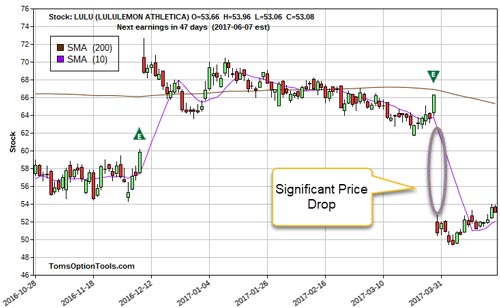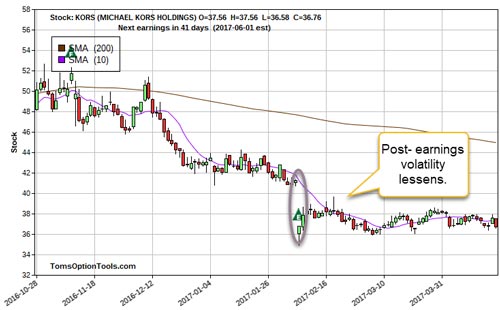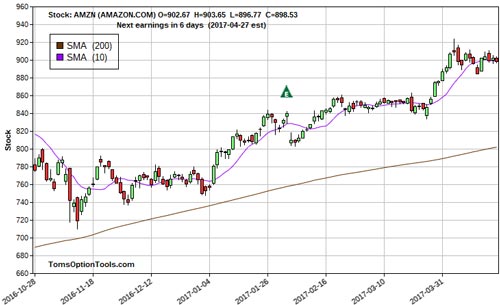The nail-biter in France is over, and the official runoff between centrist Emmanuel Macron and nationalist Marine Le Pen is set for May.
Now, early polls suggest Macron will walk off with 64% of the vote and become the next president of France. The markets agree, and, more significantly, they're indicating a Macron win will be good for France and European markets.
Whatever we might think of that, it's the market reality we'll have to contend with, and far from settling matters, this news is actually going to mean increased volatility in the near future.
So this is the perfect opportunity to bone up on what volatility really is, how best to deal with it, and, of course, the best part: how to profit from it...
Turbulence Is Really Nothing to Fear
"Volatility" has a negative connotation to most folks. They hear the word and they think, "I'm gonna lose money!" But it's really perfectly natural and not scary once you understand how it works and when it shows up.
You certainly don't have to take a portfolio hit because of it. Quite the opposite, in fact.
Volatility is really just uncertainty manifested on the markets. It's uncertainty about the change in value of a security - up or down - and how quickly or slowly that change is taking place.
Higher volatility tends to mean prices change dramatically over a short period of time, lower volatility means market participants are pretty confident the price will remain about the same, or at least change slowly over the intermediate to long term.
Even though the outcome was seen as favorable to global investors, the French election result "stirred the pot" and created some upward volatility in Goldman Sachs Group Inc. (NYSE: GS), Citigroup Inc. (NYSE: C), Bank of America Corp. (NYSE: BAC), and other banks and financials as they jumped higher.
A call strategy on stocks going up like this is a great way to turn small or modest upward moves of a couple percent or so into tidy profits, even double and triple digits, while drastically limiting your risk.
But financials are not going to be the biggest source of volatility over the next month...
Earnings Season Always Shakes Markets Up (and Down)
We are about halfway through earnings season, moving right into the thick of it. Around 80% of the companies on the S&P 500 are due to report over the next two weeks.
Earnings reports naturally always add volatility, much more so than they have for the past two weeks. In fact, over these next weeks, we're likely to see dramatic price moves as companies miss and beat their expectations in an atmosphere of higher profits overall in 2017.
I think we can expect significant downside volatility in the U.S. retail sector. It's been hit hard - I've heard it called the "Retail Ice Age" or the "Retail Apocalypse" - and it's a very challenging environment for buy-and-hold investors, but offers some juicy opportunities for nimble traders. I'll show you what I mean in a minute.
First, let's look at the price volatility around last earnings season from a couple of well-known retailers - that have had a well-known hard time recently: Lululemon Athletica Inc. (Nasdaq: LULU) and one I've talked about on CNBC World before, Michael Kors Holdings Ltd. (NYSE: KORS).
When they miss on earnings (that's the "E" in the green triangle in the graphic) or fail to paint a rosy picture going forward, the price moves, and in many cases, the drops are pretty severe:

Now let's take a closer look at what happens after earnings, when sentiment starts to firm up about forward guidance the company just reported...

You can see, most clearly with KORS, volatility increased going into and immediately after the earnings report and then lessened for a short time afterward.
Covered put options are the best way to trade stocks experiencing downside volatility, like KORS and LULU. These are generally much safer than short selling, because you can limit your risk and exposure to unexpected increases in price - pure poison if you're on the short side, because your losses are theoretically unlimited.
Now, nothing I'm seeing in retail has given me reason to change my mind about the continued challenge retail stocks will have going forward. The stocks will be volatile, and they will continue to reward traders who play on that volatility, just as much as they'll punish investors who hold them.
But there's always opportunity here.
Try This Trade Out Today for Quick Profits
[mmpazkzone name="in-story" network="9794" site="307044" id="137008" type="4"]
Right now, my favorite retail stock is Amazon.com Inc. (Nasdaq: AMZN), although it has to be said it's a massive hybrid of retail and technology.
It's crushing other retailers, gobbling up market share to such a degree that plenty of pundits (unfairly) hold it solely responsible for that "Retail Apocalypse" I mentioned. Amazon has blunted the revenue prospects of traditional retailers, who, with few exceptions, weren't as quick and adaptable out of the gate at capturing dollars spent online.
It's near all-time highs right now, so if you're a buy-and-hold investor, it may seem strange to consider it as a pure profit play, but it's a great stock to trade near-dated call options on for quick money.
And Amazon will report earnings today after the market closes, so I do mean this will be a quick trade.

Historically, AMZN shares have climbed higher after reporting, in some cases by a lot, despite hardly ever reporting positive earnings. That's upside volatility.
If you're not comfortable making the call option trade yourself, consider paper-trading it and see what happens. You'll get a front-row seat to the kind of profits volatility can bring you.
Because between earnings season and the next round of the French elections - not to mention what might come out of Washington, D.C., or fall out of the blue - volatility is coming.
You want to be one of the folks that profits from it.
Tom is recommending trades right now that pack triple-digit profit potential - fast triple-digit potential. Open a trade on a Monday, and you could close out and get paid on Thursday. That's all there is to it. This is some serious money, and you're guaranteed at least one shot at the profits each and every week. You can click here to learn more about it.
Follow Tom on Facebook and Twitter.
About the Author
Tom Gentile, options trading specialist for Money Map Press, is widely known as America's No. 1 Pattern Trader thanks to his nearly 30 years of experience spotting lucrative patterns in options trading. Tom has taught over 300,000 traders his option trading secrets in a variety of settings, including seminars and workshops. He's also a bestselling author of eight books and training courses.



